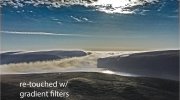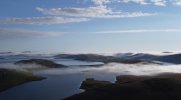- Joined
- Feb 28, 2019
- Messages
- 213
- Reactions
- 227
I like your thoughts on the shot. I should probably concentrate more on the content and as you say find the main point of interest and focus on that. Big learning curve ahead I think.It's rainy and windy here today, so instead of flyting I'll toss out a some suggestions that are probably worth about what you paid for them. Disregard freely.
It's tough with high contrast scenes like this. You might try aiming the camera down to include more the ground and less bright sky. Then you could open the exposure to brighten things, letting the sky go a little overexposed. Most of the interest in the scene in the fog, water, and ground. Maybe concentrate more on reflections from the water instead of the sun.
Was the drone facing into the sun? the 2nd photo would suggest it may have been. I would think that if the photos were taken without compensating for this it it will result in a darker foreground. Reason; the camera looks at the brightest part of the image and the result is over exposure where the sun is brightest and dark elsewhere. I find the best is manual settings as you have greater control over the shot your taking. Also composition is important and the rule of thirds applies or the golden spiral, look them up for ideas.Couple of photos trying to show the early morning foggy patches.
View attachment 130316
View attachment 130317
Be grateful if someone with the know how could improve these and let me know what they did. I tried but nothing seemed to work for me.
Couple of photos trying to show the early morning foggy patches.
View attachment 130316
View attachment 130317
Be grateful if someone with the know how could improve these and let me know what they did. I tried but nothing seemed to work for me.



 I re-touched both images using the gradient filter and the burn and doge filters. Itopened up the dark foregrounds and intensified the skies.
I re-touched both images using the gradient filter and the burn and doge filters. Itopened up the dark foregrounds and intensified the skies.Thanks for that info. I really need to put more thought in to my composition & exposure. I tend to leave it on auto rather than faff around with manual settings but I think next time I'll switch it to manual before taking off and leave it there. Played around a lot with DSLR and older SLR cameras so I should have more sense I guess.Was the drone facing into the sun? the 2nd photo would suggest it may have been. I would think that if the photos were taken without compensating for this it it will result in a darker foreground. Reason; the camera looks at the brightest part of the image and the result is over exposure where the sun is brightest and dark elsewhere. I find the best is manual settings as you have greater control over the shot your taking. Also composition is important and the rule of thirds applies or the golden spiral, look them up for ideas.
Thanks for that Dale, the images do look a lot more dramatic and the foreground has improved with being lightened. I need to look more at the filters in my photo editor and see if I have these options.View attachment 130354View attachment 130355View attachment 130358View attachment 130359I re-touched both images using the gradient filter and the burn and doge filters. Itopened up the dark foregrounds and intensified the skies.
Dale
Miami
Yep all the stuff you learnt using SLR (yes the35mm versionsThanks for that info. I really need to put more thought in to my composition & exposure. I tend to leave it on auto rather than faff around with manual settings but I think next time I'll switch it to manual before taking off and leave it there. Played around a lot with DSLR and older SLR cameras so I should have more sense I guess.
After watching the images and videos in this forum for several years, the main exposure problem I see that almost everyone has to deal with is the high dynamic range between a bright sky, including sunsets, against the dark, and underexposed foreground. In DSLR images they are easily corrected with software (I mainly use the gradient filter to bring out the shadows in the foreground). In video(using Premiere Pro) , I cannot find any sort of tool like this filter. The bright sky over powers the sensor and exposes for the bright areas, and leaves the foregrounds dark or almost with no details.Yep all the stuff you learnt using SLR (yes the35mm versions) and the DSLRs apply to drone cameras only difference is the viewing angle which is higher than normal..
you should still be able to correct for exposure if you shoot in RAW. I think the drone has a setting for thatAfter watching the images and videos in this forum for several years, the main exposure problem I see that almost everyone has to deal with is the high dynamic range between a bright sky, including sunsets, against the dark, and underexposed foreground. In DSLR images they are easily corrected with software (I mainly use the gradient filter to bring out the shadows in the foreground). In video(using Premiere Pro) , I cannot find any sort of tool like this filter. The bright sky over powers the sensor and exposes for the bright areas, and leaves the foregrounds dark or almost with no details.
I have never had the drone set for anything but RAW. Never shoot jpg. I do H.265 video and color correct in Premiere for video, and use Photoshop ACR (Adobe Camera RAW) for stills. I use gradient filter to open shadows in foregrounds. There is no way to set the lens for good exposure of a sunset/ sunrise and still retain the details in the foreground without post-processing to open shadows in foreground.you should still be able to correct for exposure if you shoot in RAW. I think the drone has a setting for that
We use essential cookies to make this site work, and optional cookies to enhance your experience.


